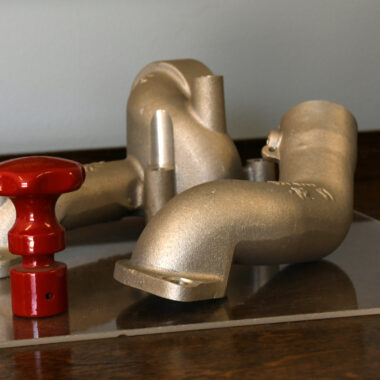Unlocking the Prospective: Casting Aluminum Illinois Made Simple
Wiki Article
Accuracy and Perfection: Finest Practices for Effective Aluminum Casting
In the realm of aluminum casting, accomplishing precision and perfection is not simply a goal however a requirement that differentiates quality. The careful procedure of aluminum casting demands attention to detail at every stage, from material selection to last ending up touches.Product Option
When taking into consideration product selection for aluminum spreading procedures, longevity, and heat resistance are paramount elements to evaluate. Aluminum alloys offer a wide variety of alternatives, each with special buildings that can dramatically affect the quality and efficiency of the last casted product. One usual option is the 356 alloy, understood for its excellent fluidness and resistance to rust, making it suitable for a selection of applications. For high-stress atmospheres requiring premium stamina, the 7075 alloy stands out as a result of its high strength-to-weight ratio. In addition, the 6061 alloy is favored for its excellent weldability and formability, making it a flexible option for detailed designs.In the option process, it is important to take into consideration not only the mechanical homes of the alloy yet additionally its thermal characteristics. Heat resistance is important to make certain that the casted component can withstand the temperatures it will be subjected to throughout procedure without jeopardizing its architectural honesty. By meticulously evaluating the resilience and warm resistance of different aluminum alloys, producers can make educated decisions that lead to premium, trustworthy casted items.
Mold And Mildew Style
In the realm of aluminum casting best practices, an integral aspect that significantly affects the end product's high quality and stability is the precise style of the mold. Mold and mildew layout plays a critical duty in figuring out the dimensional accuracy, surface coating, and total ins and out of the cast aluminum component. When producing a mold for light weight aluminum casting, several key variables need to be thought about to guarantee optimal outcomes.First of all, the mold layout ought to account for the product flow characteristics of liquified aluminum to avoid issues such as shrinking, porosity, or misruns. Proper gating and riser positioning are vital elements in the mold and mildew design procedure to help with smooth steel flow and minimize the development of air pockets.
Additionally, the mold and mildew design need to consider the cooling price of the aluminum to avoid breaking or distortion throughout solidification. Sufficient airing vent and cooling networks within the mold can assist manage the temperature level circulation and promote consistent solidification of the steel.
Process Optimization
To boost efficiency and quality in aluminum casting, process optimization plays a critical role in making best use of and streamlining procedures result. By fine-tuning each action of the spreading procedure, makers can recognize traffic jams, lower waste, and boost total efficiency.Additionally, carrying out lean manufacturing principles can even more enhance procedure optimization in light weight aluminum spreading. By getting rid of non-value-added activities and focusing on constant improvement, manufacturers can attain greater effectiveness levels and better source use. Furthermore, regular surveillance and evaluation of essential performance indications (KPIs) assist in identifying locations for enhancement and making data-driven decisions to maximize the spreading process continually.
Top Quality Control
Process optimization in light weight aluminum spreading not only boosts effectiveness and productivity yet likewise lays the structure for rigid quality assurance actions to maintain industry criteria. Quality control is extremely important in making sure that final light weight aluminum castings satisfy the required requirements and performance standards. Executing a thorough quality assurance procedure involves numerous steps, beginning from the initial style stage through to the last inspection of the actors components.her explanation

Additionally, developing clear quality assurance protocols and documents procedures is important for monitoring and keeping track of the spreading procedure. By maintaining detailed documents of production parameters, testing results, and assessment records, makers can make sure consistency and traceability in their light weight aluminum casting procedures. Sticking to rigorous quality control techniques not only boosts the general integrity of aluminum spreadings however additionally instills self-confidence in customers pertaining to the quality of the end products.
Completing Strategies
How can aluminum casting be improved via thorough application of finishing techniques? Finishing methods play a vital duty in boosting the top quality and visual appeals of aluminum castings.
Furthermore, methods like powder covering or paint can be related to aluminum spreadings to provide both visual allure and additional defense against environmental variables. By thoroughly choosing and using the suitable ending up techniques, producers can make certain that their aluminum castings satisfy the highest possible standards of top quality and performance.
Final Thought
In verdict, successful aluminum casting calls for accuracy and perfection in material choice, mold and mildew layout, procedure optimization, quality control, and completing methods. By adhering to ideal practices in each of these areas, producers can make sure consistent and premium cause their light weight aluminum casting procedures. casting aluminum illinois. It is crucial to take note of every detail and continuously pursue enhancement to accomplish ideal results in aluminum castingThe precise reference process of aluminum casting demands attention to detail at every phase, from product option to last ending up touches.To improve effectiveness and high quality in aluminum casting, process optimization plays a pivotal duty in maximizing and streamlining procedures outcome.Process optimization in aluminum spreading not just improves efficiency and productivity yet likewise lays the foundation for stringent top quality control actions to maintain market criteria.One essential aspect of quality control in light weight aluminum spreading is the usage of advanced testing methods to evaluate the honesty and buildings of the spreadings.In conclusion, effective aluminum casting needs precision and excellence click now in material option, mold design, procedure optimization, quality control, and ending up techniques.
Report this wiki page